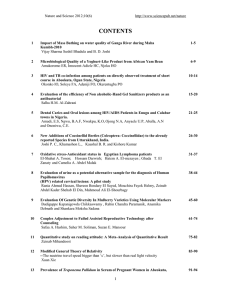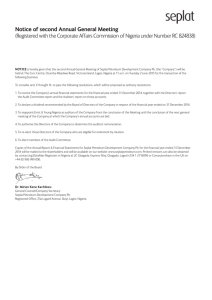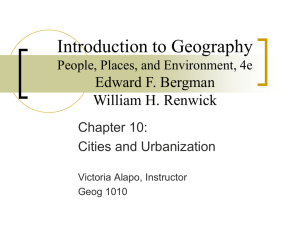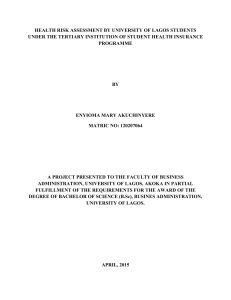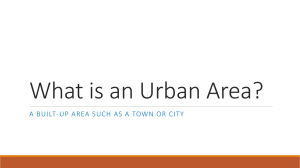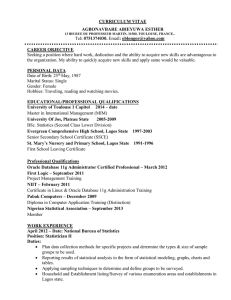Course Course Duration Lecturer:
advertisement
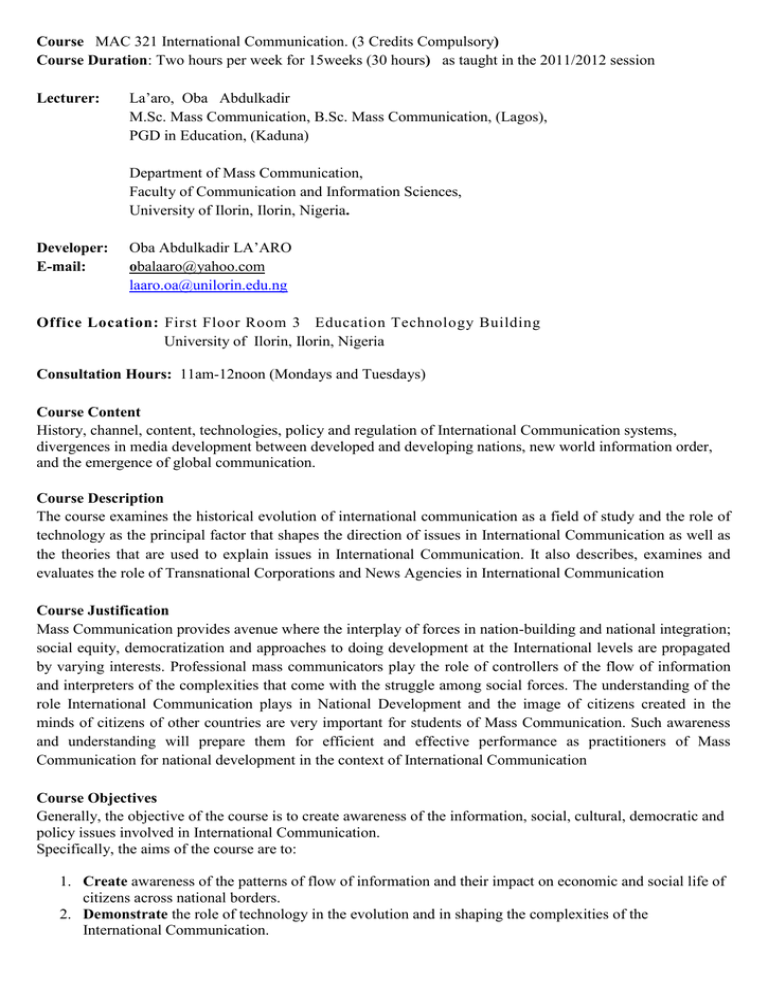
Course MAC 321 International Communication. (3 Credits Compulsory) Course Duration: Two hours per week for 15weeks (30 hours) as taught in the 2011/2012 session Lecturer: La’aro, Oba Abdulkadir M.Sc. Mass Communication, B.Sc. Mass Communication, (Lagos), PGD in Education, (Kaduna) Department of Mass Communication, Faculty of Communication and Information Sciences, University of Ilorin, Ilorin, Nigeria. Developer: E-mail: Oba Abdulkadir LA’ARO obalaaro@yahoo.com laaro.oa@unilorin.edu.ng Office Location: First Floor Room 3 Education Technology Building University of Ilorin, Ilorin, Nigeria Consultation Hours: 11am-12noon (Mondays and Tuesdays) Course Content History, channel, content, technologies, policy and regulation of International Communication systems, divergences in media development between developed and developing nations, new world information order, and the emergence of global communication. Course Description The course examines the historical evolution of international communication as a field of study and the role of technology as the principal factor that shapes the direction of issues in International Communication as well as the theories that are used to explain issues in International Communication. It also describes, examines and evaluates the role of Transnational Corporations and News Agencies in International Communication Course Justification Mass Communication provides avenue where the interplay of forces in nation-building and national integration; social equity, democratization and approaches to doing development at the International levels are propagated by varying interests. Professional mass communicators play the role of controllers of the flow of information and interpreters of the complexities that come with the struggle among social forces. The understanding of the role International Communication plays in National Development and the image of citizens created in the minds of citizens of other countries are very important for students of Mass Communication. Such awareness and understanding will prepare them for efficient and effective performance as practitioners of Mass Communication for national development in the context of International Communication Course Objectives Generally, the objective of the course is to create awareness of the information, social, cultural, democratic and policy issues involved in International Communication. Specifically, the aims of the course are to: 1. Create awareness of the patterns of flow of information and their impact on economic and social life of citizens across national borders. 2. Demonstrate the role of technology in the evolution and in shaping the complexities of the International Communication. 3. Build skills in the students in analyzing issues involved in International Communications. Course Requirements This course is compulsory for all 300 level students in the Department of Mass Communication without which a student cannot graduate. For this reason every student must meet the following :( 1). Participate actively in class discussion and attain a minimum attendance of 75% (2). Join an internet discussion group created for the course.All students are expected to have a yahoo e-mail account in order to facilitate web-interaction Methods of Grading The evaluation criteria, based on the activities of the course, are as distributed below. Grading criteria Score (%) Test/ Assignment 10 Seminar presentation 15 Participation in class and online discussion 05 group Final examination 70 TOTAL 100 Course Delivery Strategies Face-to-face lectures involving theoretical and practical sessions will be the major method of course delivery. Students will be assigned into groups and will be expected to present group work in rehearsal sessions. An online discussion group would be available to all students of the course to exchange ideas. These include weekly class lectures by the lecturer in charge and Seminar presentations by students. Lecture Content WEEK 1: Introduction to International Communication. Objective At the end of the lecture, students should have clear understanding of the concept and evolution of the field of International Communication. Description: First Hour. An overview of the course through definitions of the concepts of International Communication shall be provided and extensively discussed. Second Hour An exposition on the factors/issues which contribute to the growth of International Communication shall be discussed. Study Questions 1. Identify and discuss two definitions of international communication. 2. What are the factors that contribute to the growth of international communication? 3. What is the main distinguishing attributes of international communication to other levels of communication. 4. Is there any difference between foreign communication system and International communication? 5. What is this course all about? 2 Reading list 1. Thussu, D K.(2002),International communication, continuity and change, London; ArnoldHolder Headline Group pp.1-13 ISBN 0 340 74130 9(hb) 0 340 74131 7(pb) 2. Aina, Sina.(2003),Global communications and the media agenda, Abeokuta, Julian PublishersDr.Watts House. Pp-17-32 ISBN-978-33146-9-6 WEEK 2: Perspectives and Dimensions of International Communication. Objective At the end of lecture student is expected to be able to explain the different perspectives and dimensions of International Communication. Description First Hour. In-depth discussions of the system perspectives, communication/development perspectives, Institutional/commercial perspectives and technological/legal perspectives Second Hour Focus on issues that have defined the dimensions of analyzing international communication e.g.--Image, Flow of Information, Cultural Bias, and Bias in Media Coverage etc Study Questions 1. What is the value of the system perspectives to international communication? 2. What is the relevance of institutional/commercial perspectives to International Communication?. 3. What is meant by flow of information? 4. Study and analyse the sources of International News covered by local newspapers. 5. Identify the major challenges of the local newspaper in covering international issues? Reading list 1. Luke, Uka U,(1996),The order of north-south information dichotomy in post-cold war Era,Lagos,Longman Nigeria Plc,pp 1-17. 2. Aina, Sina(2003), Global communications and the media agenda, Abeokuta, Julian PublishersDr.Watts House. ISBN-978-33146-9-6 3. Thussu, D K.(2002),International communication, continuity and change, London; ArnoldHolder Headline Group pp.1-13. ISBN 0 340 74130 9(hb) 0 340 74131 7(pb) WEEK 3: Agencies and Channels of International Communication. Objective. At the end of the lecture, student will be able to trace the history and explain the functions/roles of news agencies in the world and have awareness of the avenues of international communication flow. Description First Hour Identification of the avenues/channel of international communication flows. Second Hour It will involve identification and discussion of types, history and roles of major News Agencies in the world and regions. Study Questions. 1. What is the contribution of technology to the growth of international communication flow? 2. What role does tourism play in International communication flow? 3. How does scholarship serve as avenue for international communication flow? 3 4. How does the news agency contribute to balance issues in international flow of communication? 5. How do technological advancement affect the media content? Reading list. 1. Luke, Uka U,(1996),The Order of north-south Information Dichotomy in Post-cold war Era,Lagos,Longman Nigeria Plc,pp 1-17. 2. Aina, Sina(2003),Global communications and the media agenda, Abeokuta, Julian PublishersDr.Watts House.pp 73-85. ISBN-978-33146-9-6 3. Thussu, D K.(2002),International communication, continuity and change, London; ArnoldHolder Headline Group pp.1-13. ISBN 0 340 74130 9(hb) 0 340 74131 7(pb) WEEK 4: Model/Theories of International Communication (i) Objective To let students have awareness and understanding of the key assumptions and propositions of the theories of International Communications. First Hour A discussion, in the context of International Communication, of the theories on: free flow of information,modernization and,Dependency, Second Hour A discussion, in the context of International Communication, of the theories on: free flow of information,modernization and,Dependency . Study Questions. 1. Discuss the relationship between ‘free flow of information’ and the issue of ‘imbalance in news flow’ 2. What is the difference between modernization theory and dependency theory? 3. What are the contributions of the following scholars to modernization theory? Daniel Lerner; Wilbur Schramm; and Everest Rogers 4. Identify and discuss the role of Trans-National Corporations (TNCs) in International Communication. 5 How do the local news agencies contribute to the reduction in imbalance in news flow? Reading list 1. Aina, Sina(2003),Global communications and the media agenda, Abeokuta, Julian PublishersDr.Watts House.pp 161-171. ISBN-978-33146-9-6 2. Luke, Uka U,(1996),The Order of north-south information dichotomy in post-cold war Era,Lagos,Longman Nigeria Plc,pp 19-37 3. Thussu, D K.(2002), International communication, continuity and change, London; ArnoldHolder Headline Group pp.53-64. ISBN 0 340 74130 9(hb) 0 340 74131 7(pb) WEEK 5: Model/Theories of International Communication.(ii) Objective: To make students have understanding of the theories relevant to international communication and use them to explain the social and political phenomena and processes which define the world system.(i.e. structural imperialism, hegemony, critical theories etc) First Hour It will be a discussion of the Concepts, Assumptions and Propositions of the theories. 4 Second Hour. Student shall be engaged to appraise the validity of the theories discussed so far. Study Questions. 1. Do you agree with the propositions of the critical theorist?. 2. Explain what is meant by ‘commodification’ and ‘mass culture’ 3. To what way is the hegemony theory relevant to the study of International communication? 4. What is the main proposition of the theories discussed so far? 5. How do the theories help your understanding of the issues in international communication? Assignment. Selected readings on information societies and globalization to be discussed in a class seminar . Reading List 1. Aina, Sina(2003),Global communications and the media Agenda, Abeokuta, Julian PublishersDr.Watts House.pp 161-171. ISBN-978-33146-9-6\ 2. Littlejohn, S W. and Foss, K.A,(2005),Theories of Human Communication,Belmont,Thomas Wadsworth pp 26-28( International Students Edition 3. Luke, Uka U,(1996),The Order Of North-South Information Dichotomy in Post-cold war Era,Lagos,Longman Nigeria Plc,pp 19-37 4. Thussu, D K.(2002),International Communication, continuity and change, London; ArnoldHolder Headline Group pp.53-64. ISBN 0 340 74130 9(hb) 0 340 74131 7(pb WEEK 6: The NWICO debate and WSIS Objective. At the end of the lecture, students should have understanding of the essence and contributions of NWICO and WSIS to International Communication. First Hour. Students shall be introduced to the development which led to the NWICO debate and the central issues of the debate as well as the outcome of the debate. Second Hour The focus will be on the rationale and principles of WSIS. Study Questions. 1. Discuss the contributions of the Mustapha Masmoudi and Mahtar M’Bow to the NWICO Debate? 2. What are the grievances of the third world countries against the pattern of information flow that led to the NWICO Debate.? 3. What was the response of the Western World to the grievances of third world and how justifiable? 4. Discuss the consequences/gains of the NWICO Debate? 5. What are the challenges of implementing the recommendations of the NWICO debate? Reading list. Aina, Sina(2003),Global Communications and the Media Agenda, Abeokuta, Julian PublishersDr.Watts House.pp 372--399. ISBN-978-33146-9-6 Luke, Uka U,(1996),The Order Of North-South Information Dichotomy in Post-cold war Era,Lagos,Longman Nigeria Plc,pp 114-129. Thussu, D K.(2002),International Communication, continuity and change, London; Arnold-Holder Headline Group pp.43-51. ISBN 0 340 74130 9(hb) 0 340 74131 7(pb) 5 Lorimer, R.(1989) Mass Communications, A Comparative Introduction,Manchester,Manchester University Press, WEEK 7: Issues in Global NEWS: definitions and perspectives. Objective At the end of the lecture students should be able to identify and discuss intelligently the peculiar nature of International News and the various issues around it. First Hour It will involve explanation of the complexities of global news orientations (i.e. market driven; occidental (western) and sociological dimensions). Second Hour It will give comprehensive discussion of the issues of ethnocentrism (focus on political rather than people and social trends) in Global news coverage; the directions of Global news coverage etc. Study Questions 1. Compare and contrast two definitions of news discussed in this lecture. 2. Compare coverage of foreign affairs in local newspapers to radio in terms of themes. 3. How do news values contribute to distortion in news flow? 4. How does gate keeping functions of the journalists contribute to global news flow? 5. Explain the concept of global news. Reading list Aina, Sina(2003),Global Communications and the Media Agenda, Abeokuta, Julian PublishersDr.Watts House.pp 317--341. ISBN-978-33146-9-6 Luke, Uka U,(1996),The Order Of North-South Information Dichotomy in Post-cold war Era,Lagos,Longman Nigeria Plc,pp 1-17,210--228. Thussu, D K.(2002),International Communication, continuity and change, London; Arnold-Holder Headline Group pp.119--163 ISBN 0 340 74130 9(hb) 0 340 74131 7(pb) Lorimer, R.(1989) Mass Communications, A Comparative Introduction,Manchester,Manchester University Press, pp236-238. Weeks 8: Test Objective: the main of objective of the test is to determine the student’s ability to analyse certain issues in international communication. Description First Hour & Second Hour. Test administration WEEK 9 Global Communication Infrastructures. Objective. The students are to be made aware of the shifting emphasis of analyzing International Communication from government to government to that of communication infrastructure and those who control it. First Hour An overview of the global satellite industry and its impact on global communication Second Hour. It will involve a discussion of the hardware of International Communication and the role of Transnational Corporations. 6 Study Questions. 1. Examine the impact of WTO on International Communication. 2. Describe the role of International Telecommunication Union. 3. Trace the evolution of satellite broadcasting in your country 4. What is the impact of WTO on communication industry in your country? Reading list Aina, Sina(2003),Global Communications and the Media Agenda, Abeokuta, Julian Publishers- Dr.Watts House.pp 214- 242. ISBN-978-33146-9-6 Luke, Uka U,(1996),The Order Of North-South Information Dichotomy in Post-cold war Era,Lagos,Longman Nigeria Plc,pp 19-36; Thussu, D K.(2002),International Communication, continuity and change, London; Arnold-Holder Headline Group pp.82-115 ISBN 0 340 74130 9(hb) 0 340 74131 7(pb) Babcock Journal of mass Communication, vol 2 No 1 January, 2009, pp 128--137. Lorimer, R.(1989) Mass Communications, A Comparative Introduction,Manchester,Manchester University Press, pp 143-144 WEEK10: Global Media Market Objective Is to demonstrate and explain the trend and impact of the convergence of media and technologies on global and international communication. First Hour It will give explanation of the role of deregulation policy in bringing about integration of many media industries with some examples. Second Hour. a discussion of the applications of the principles of synergies in global media industry. Study Questions 1. What is the major policy that helps to bring about convergence of the media in the world? 2. With specific examples, discuss the synergy process in global media markets. 3. What are influences of global media on Nigerian media industry? 4. What is the prospect of applying the principles of synergies in Nigerian Media? 5. What is the difference between deregulation and liberalisation of the media industry?. Reading list Aina, Sina(2003),Global Communications and the Media Agenda, Abeokuta, Julian PublishersDr.Watts House.pp . ISBN-978-33146-9-6 Luke, Uka U,(1996),The Order Of North-South Information Dichotomy in Post-cold war Era,Lagos,Longman Nigeria Plc,pp 19-36; Thussu, D K.(2002),International Communication, continuity and change, London; Arnold-Holder Headline Group pp.118-141 ISBN 0 340 74130 9(hb) 0 340 74131 7(pb) Lorimer, R.(1989) Mass Communications, A Comparative Introduction,Manchester,Manchester University Press, 145-150 WEEK11: Globalization & Mass Communication Objective. Is to let students identify and understand the practice and contribution of different areas of mass communication to the globalization phenomenon. First Hour. It will involve the description of the roles and structure of International Film industry and Book Publishing and the major players. Second Hourr. 7 This will also describe the structure and contribution of the international print media and the international advertising to global communication. Study Questions. 1. Define what is meant by global media markets. 2. Explain why the term ‘glocalisation’ was coined 3. Identify and explain the major contributors to global film industry. 4. What are the defining characteristics of international Advertising? 5. Explain the mutual roles international media in sustaining one and the other. Reading list Aina, Sina(2003),Global Communications and the Media Agenda, Abeokuta, Julian PublishersDr.Watts House.pp 294--316. ISBN-978-33146-9-6 Uche, Luke Uka, ,(1996),The Order Of North-South Information Dichotomy in Post-cold war Era,Lagos,Longman Nigeria Plc,pp Uche, Luke Uka(ed), (1999)Mass communication Democracy and Civil Society in Africa,International Pespectives,Lagos,UNESCO-NATCOM.pp 461-541 Thussu, D K.(2002),International Communication, continuity and change, London; Arnold-Holder Headline Group pp.140-165 ISBN 0 340 74130 9(hb) 0 340 74131 7(pb) WEEK 12: Cultural Globalization: Issues of Concern. Objective The aim is to expose students to issues that have raised the concern of scholars in International Communication and globalization of communication products. First Hour It will involve a discussion of Globalization and Western culture as well as directions of flow of programmes. Second Hour The focus is on the implications of one- way flow of media products on cultural diversity. Study Questions. 1. Define cultural globalization. 2. In the context of globalization, what is meant by consumer culture? 3. With relevant examples, explain why globalization is typical of Western Culture? 4. What will you suggest to bring about balance in the exchange in the flow of cultures in globalised world? Reading list Aina, Sina(2003),Global Communications and the Media Agenda, Abeokuta, Julian PublishersDr.Watts House.pp 294--316. ISBN-978-33146-9-6 Uche, Luke Uka, ,(1996),The Order Of North-South Information Dichotomy in Post-cold war Era,Lagos,Longman Nigeria Plc,pp Uche, Luke Uka(ed), (1999)Mass communication Democracy and Civil Society in Africa,International Pespectives,Lagos,UNESCO-NATCOM.pp 461-541 Thussu, D K.(2002),International Communication, continuity and change, London; Arnold-Holder Headline Group pp.140-165 ISBN 0 340 74130 9(hb) 0 340 74131 7(pb) Weeks 13: Seminar Presentations. Group or individual Objective: the main of objective of the test is to determine the student’s ability to analyse certain issues in international communication. Description First Hour 8 Seminar presentation Second Hour Seminar presentation A discussion, in the context of International Communication, of the theories on: free flow of information,modernization and,Dependency. WEEK 14: Internet Age and International Communication. Objective: It is aimed at increasing the awareness of the students of the role of the internet in world affairs. First Hour A brief description of the attributes of the internet and provide a link to the past technologies. Second Hour It is will demonstrate of the applications of internet facilities in the local media and among local audiences. Study Questions 1. How does the internet advance the interest of the Western world? 2. What is meant by digital divide and its implication on world affairs? 3. Examine the connection between the notion of digital divide and social tension in third world countries especially Nigeria. 4. Critically examine the connection between the internet and mass communication. Reading List Aina, Sina(2003),Global Communications and the Media Agenda, Abeokuta, Julian PublishersDr.Watts House.pp214--242. ISBN-978-33146-9-6 Uche, Luke Uka(ed), (1999)Mass communication Democracy and Civil Society in Africa,International Pespectives,Lagos,UNESCO-NATCOM.pp 189--234 Thussu, D K.(2002),International Communication, continuity and change, London;pp.225--254 ISBN 0 340 74130 9(hb) 0 340 74131 7(pb) WEEK 15. Revision: This week will be devoted to revision of both theory and practical activities demonstrated in previous lectures. All the study questions and assignments from week one to fourteen would be revised and treated as follows: Study Questions 1. Identify and discuss two definitions and the factors that contribute to the growth of international communication? 2. Compare and contrast the system perspectives and the institutional/commercial perspectives to International Communication. 3. Identify and explain media coverage that serves as example of media bias. 4. What is the contribution of technology to the growth of international communication flow? 5. What role does tourism play in International communication flow? 6. Discuss the relationship between ‘free flow of information’ and the issue of ‘imbalance in news flow’. 7. Explain what is meant by ‘commodification’ and ‘mass culture’ 8. In what way is the hegemony theory relevant to the study of International communication? 9. Compare and contrast two definitions of news discussed. 10. Examine the impact of WTO on International Communication. 11. With specific examples, discuss the synergy process in global media markets 12. What are the defining characteristics of International Advertising? 9 13. What is meant by digital divide and its implications on world affairs? Legend 1. Available in University Library 2. Available in Local Bookshop 3. Personal collections 4. Available Departmental library 10
